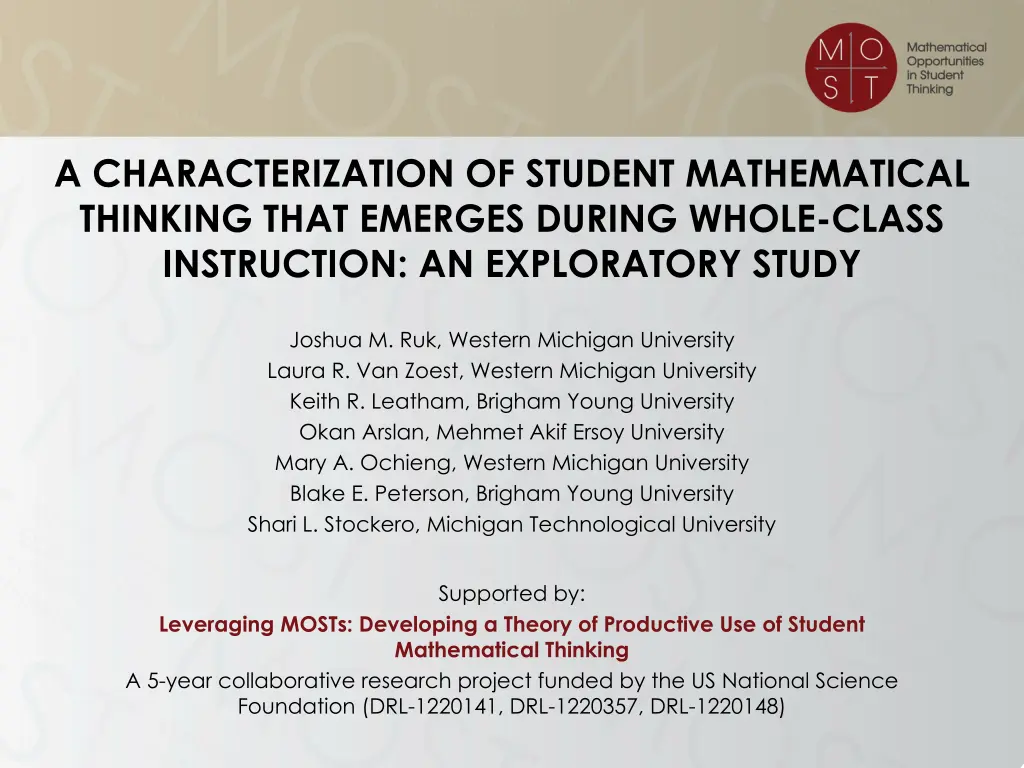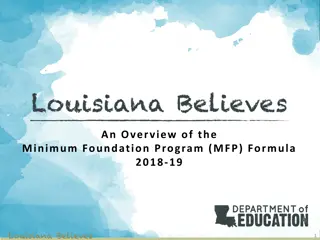
Understanding Student Mathematical Thinking in Whole-Class Instruction
Explore an exploratory study on student mathematical thinking during whole-class instruction, the importance of incorporating student thinking, and the theoretical framework for characterizing student thinking. The study aims to characterize and theorize about building upon student mathematical thinking to enhance learning outcomes in mathematics classrooms.
Download Presentation

Please find below an Image/Link to download the presentation.
The content on the website is provided AS IS for your information and personal use only. It may not be sold, licensed, or shared on other websites without obtaining consent from the author. If you encounter any issues during the download, it is possible that the publisher has removed the file from their server.
You are allowed to download the files provided on this website for personal or commercial use, subject to the condition that they are used lawfully. All files are the property of their respective owners.
The content on the website is provided AS IS for your information and personal use only. It may not be sold, licensed, or shared on other websites without obtaining consent from the author.
E N D
Presentation Transcript
A CHARACTERIZATION OF STUDENT MATHEMATICAL THINKING THAT EMERGES DURING WHOLE-CLASS INSTRUCTION: AN EXPLORATORY STUDY Joshua M. Ruk, Western Michigan University Laura R. Van Zoest, Western Michigan University Keith R. Leatham, Brigham Young University Okan Arslan, Mehmet Akif Ersoy University Mary A. Ochieng, Western Michigan University Blake E. Peterson, Brigham Young University Shari L. Stockero, Michigan Technological University Supported by: Leveraging MOSTs: Developing a Theory of Productive Use of Student Mathematical Thinking A 5-year collaborative research project funded by the US National Science Foundation (DRL-1220141, DRL-1220357, DRL-1220148)
Incorporating Student Mathematical Thinking Meaningfully incorporating student thinking is encouraged (NCTM, 2000, 2007) Such incorporation is beneficial (Fennema, et al., 1996; Stein & Lane, 1996) Not all thinking has the same potential to support learning (Leatham, Peterson, Stockero, & Van Zoest, 2015) It can be difficult to use student thinking in the moment (Peterson & Leatham, 2009; Scherrer & Stein, 2013; Stockero, Van Zoest & Taylor, 2010)
Our Research Purposes Characterize the student mathematical thinking that emerges during whole-class instruction in one teacher s classroom Theorize about the potential to build on the student mathematical thinking that emerges during whole-class instruction
Theoretical Framework Mathematically significant pedagogical Opportunities to build on Student Thinking (MOSTs) Six criteria for characterizing student thinking (Leatham et al. 2015)
Methodology This study is part of a larger project 11 videotaped mathematics lessons 6-12th grade classrooms The particular classroom for this study An average lesson from the larger data set 90-minute junior-level geometry lesson 45-minutes spent in whole-class instruction 164 instances of student thinking
MOST Criteria MOST Criterion % of Instances (#) Building Potential % of Instances (#) Pedagogical Timing (MOST) 16.5% (27) High 16.5% (27) Pedagogical Opening 1.8% (3) Some 34.7% (57) Central Mathematics 32.9% (54) Appropriate Mathematics 2.4% (4) Mathematical Point 9.8% (16) No 29.9% (49) Student Mathematics 17.7% (29) Cannot Infer 18.9% (31) Unknown 18.9% (31)
Theorizing Potential High not building on a MOST would be a missed opportunity Some building on these could move student learning forward, but not building would not be a missed opportunity None pursuing these would be a pedagogical misstep Unknown building on these in their current form would be a pedagogical misstep
Sense-Making Examples Potential Sense-Making Subcategory Examples Instance of student mathematical thinking (SMT) and accompanying details High The teacher begins talking about great circles and a student asks a question. Instance of SMT: Would it be kind of be like the circumference of a circle? Mathematical Point (MP): A great circle is a circle of maximum circumference that can be drawn on a sphere; the great circle is the object (circle) and the circumference is the distance around the circle. MOST Coding: MOST Some After doing a hands-on experiment, the teacher asks if the surface area of a sphere is more like the area or circumference of a circle. Instance of SMT: Area, because the circumference is just the outside, like a line [outlines a circle in the air]. And then the area s the whole thing. Mathematical Point: Circumference is the distance around a circle and area is the space that circle takes up. MOST Coding: Central Mathematics
Conclusion Student thinking varies substantially Variation in Building Potential highlights the complexity of teaching
References Fennema, E., Carpenter, T. P., Franke, M. L., Levi, L., Jacobs, V. R., & Empson, S. B. (1996). A longitudinal study of learning to use children's thinking in mathematics instruction. Journal for research in mathematics education, 27, 403-434. Leatham, K. R., Peterson, B. E., Stockero, S. L, & Van Zoest, L. R. (2015). Conceptualizing mathematically significant pedagogical opportunities to build on student thinking. Journal for Research in Mathematics Education, 46, 88-124. National Council of Teachers of Mathematics. (2014). Principles to actions: Ensuring mathematical success for all. Reston, VA: Author. Peterson, B. E., & Leatham, K. R. (2009). Learning to use students' mathematical thinking to orchestrate a class discussion. In L. Knott (Ed.), The role of mathematics discourse in producing leaders of discourse (pp. 99-128). Charlotte, NC: Information Age. Scherrer, J., & Stein, M. K. (2013). Effects of a coding intervention on what teachers learn to notice during whole-group discussion. Journal of Mathematics Teacher Educators, 16, 105-124. Stockero, S. L., & Van Zoest, L. R. (2013). Characterizing pivotal teaching moments in beginning mathematics teachers practice. Journal of Mathematics Teacher Education, 16, 125-147.
Subcategories of Unknown Building Potential Subcategory Examples for Unknown Building Potential Instance of student mathematical thinking (SMT) and accompanying details Subcategories (Frequency) Students are considering the shape made by a hemisphere on top of a cube (with the side of the square equal to the diameter of the hemisphere), and have made a claim about the area of the face of the cube covered by the hemisphere. This situation prompts a student interjection. Instance of SMT: Subtract it! MOST Coding: CNI Student Ambiguity (14) After the class determines that the surface area of an orange peel fills up four great circles, they are contemplating what this means for the surface area formula. One student (S1) suggests that they should multiply base times height times four and another (S2) suggests finding the circumference. In response, the teacher asks the class, Do you find the circumference (pointing toward S2), or do you find the area (pointing toward S1)? Instance of SMT: Area. MOST Coding: CNI Teacher Ambiguity (13) After deriving the formula for volume of a sphere and arriving at V=(4 r^3)/3, the teacher projects her next slide showing the formula as V=4/3 r^3. The teacher notices that her slide differs from what she had derived and asks the students if it matters. Instance of SMT: No. MOST Coding: CNI Leading Questions (4)






















